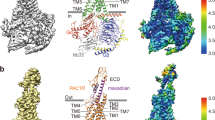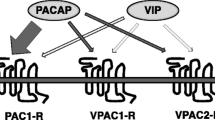Abstract
Pituitary adenylate cyclase activating polypeptide 38 (PACAP38), one of the major peptide transmitters, has emerged as a promising drug candidate for the treatment of type 2 diabetes. In the present study, on the basis of previous structure-activity relationships, a new PACAP38 derivative, [R15, 20, 21, L17]-PACAP38, was chemically synthesized with the aim of enhancing the therapeutic potential of PACAP38. The solution structure of the new derivative was almost identical to that of PACAP38 as evaluated by circular dichroic spectroscopy, and both PACAP38 and the new derivative stimulated adenylate cyclase in rat insulinoma RIN-m5F cells with EC50 values of 4.6 and 5.5 nM, respectively. Stability studies revealed the gradual degradation of PACAPs in rat serum, although there appeared to be a 42% reduction in degradation kinetics for [R15, 20, 21, L17]-PACAP38 compared with that of PACAP38. The novel derivative also exhibited more potent protective effects against streptozotocin (STZ)-induced apoptotic death of RIN-m5F cells, possibly due to the enhanced stability. The n0-STZ model, in which neonatal rats were injected with STZ at birth, developed a typical diabetic condition; however, chronic administration of [R15, 20, 21, L17]-PACAP38 resulted in protection of pancreatic islets, followed by the improvement of glycemic control. Thus, the chemical modification of PACAP38 led to the development of a new promising derivative with enhanced stability and biological activity, and early administration of [R15, 20, 21, L17]-PACAP38 might be of help for preventing the development of diabetes in type 2 diabetic model rats.





Similar content being viewed by others
References
Ahren B (2008) Role of pituitary adenylate cyclase-activating polypeptide in the pancreatic endocrine system. Ann N Y Acad Sci 1144:28–35
Araki N, Takagi K (1992) Relaxant effect of pituitary adenylate cyclase-activating polypeptide on guinea-pig tracheal smooth muscle. Eur J Pharmacol 216:113–117
Arimura A (1998) Perspectives on pituitary adenylate cyclase activating polypeptide (PACAP) in the neuroendocrine, endocrine, and nervous systems. Jpn J Physiol 48:301–331
Bonora E (2008) Protection of pancreatic beta-cells: is it feasible? Nutr Metab Cardiovasc Dis 18:74–83
Bourgault S, Vaudry D, Botia B, Couvineau A, Laburthe M, Vaudry H, Fournier A (2008) Novel stable PACAP analogs with potent activity towards the PAC1 receptor. Peptides 29:919–932
Cnop M, Welsh N, Jonas JC, Jorns A, Lenzen S, Eizirik DL (2005) Mechanisms of pancreatic beta-cell death in type 1 and type 2 diabetes: many differences, few similarities. Diabetes 54(Suppl 2):S97–S107
Finegood DT, McArthur MD, Kojwang D, Thomas MJ, Topp BG, Leonard T, Buckingham RE (2001) Beta-cell mass dynamics in Zucker diabetic fatty rats. Rosiglitazone prevents the rise in net cell death. Diabetes 50:1021–1029
Gazdar AF, Chick WL, Oie HK, Sims HL, King DL, Weir GC, Lauris V (1980) Continuous, clonal, insulin- and somatostatin-secreting cell lines established from a transplantable rat islet cell tumor. Proc Natl Acad Sci U S A 77:3519–3523
Greenfield N, Fasman GD (1969) Computed circular dichroism spectra for the evaluation of protein conformation. Biochemistry 8:4108–4116
Hanato J, Kuriyama K, Mizumoto T, Debari K, Hatanaka J, Onoue S, Yamada S (2009) Liposomal formulations of glucagon-like peptide-1: improved bioavailability and anti-diabetic effect. Int J Pharm 382:111–116
Hohmeier HE, Tran VV, Chen G, Gasa R, Newgard CB (2003) Inflammatory mechanisms in diabetes: lessons from the beta-cell. Int J Obes Relat Metab Disord 27(Suppl 3):S12–S16
Inooka H, Endo S, Kitada C, Mizuta E, Fujino M (1992) Pituitary adenylate cyclase activating polypeptide (PACAP) with 27 residues. Conformation determined by 1H NMR and CD spectroscopies and distance geometry in 25% methanol solution. Int J Pept Protein Res 40:456–464
Inooka H, Ohtaki T, Kitahara O, Ikegami T, Endo S, Kitada C, Ogi K, Onda H, Fujino M, Shirakawa M (2001) Conformation of a peptide ligand bound to its G-protein coupled receptor. Nat Struct Biol 8:161–165
Irako T, Akamizu T, Hosoda H, Iwakura H, Ariyasu H, Tojo K, Tajima N, Kangawa K (2006) Ghrelin prevents development of diabetes at adult age in streptozotocin-treated newborn rats. Diabetologia 49:1264–1273
Kashimoto K, Nagano Y, Suitani Y, Hamanaka K, Mizumoto T, Tomizaki K, Takahata H, Nagamoto A, Ohata A, Yoshihara S, Ichimura T (1996) Structure-activity relationship studies of PACAP-27 and VIP analogues. Ann N Y Acad Sci 805:505–510
Kitada C, Sakiyama A, Watanabe T, Fujino M (1991) Synthesis and structure-activity relationships of PACAP. Pept Chem 1990:239–244
Kwon DY, Kim YS, Ahn IS, da Kim S, Kang S, Hong SM, Park S (2009) Exendin-4 potentiates insulinotropic action partly via increasing beta-cell proliferation and neogenesis and decreasing apoptosis in association with the attenuation of endoplasmic reticulum stress in islets of diabetic rats. J Pharmacol Sci 111:361–371
Lenzen S, Drinkgern J, Tiedge M (1996) Low antioxidant enzyme gene expression in pancreatic islets compared with various other mouse tissues. Free Radic Biol Med 20:463–466
Liu HM, Liu XF, Yao JL, Wang CL, Yu Y, Wang R (2006) Utilization of combined chemical modifications to enhance the blood-brain barrier permeability and pharmacological activity of endomorphin-1. J Pharmacol Exp Ther 319:308–316
Merrifield RB (1969) Solid-phase peptide synthesis. Adv Enzymol Relat Areas Mol Biol 32:221–296
Movassat J, Portha B (2007) Early administration of keratinocyte growth factor improves {beta}-cell regeneration in rat with streptozotocin-induced diabetes. J Endocrinol 195:333–340
Nakata M, Yada T (2007) PACAP in the glucose and energy homeostasis: physiological role and therapeutic potential. Curr Pharm Des 13:1105–1112
Naruse S, Inoue T, Mochizuki T, Yanaihara N (1992) Vasodilator action of guinea pig vasoactive intestinal polypeptide (VIP): comparison with common mammalian VIP. Regul Pept 42:163–171
Nokihara K, Ando E, Naruse S, Nakamura T, Wray V (1993) Highly efficient synthesis of PACAP and its related peptides and their biological actions in conscious dogs. In: Okada Y (ed) 31st Symposium on Peptide Chemistry. Protein Research Foundation, Osaka, Japan, Akashi, pp 265–268
Onoue S, Matsumoto A, Nagano Y, Ohshima K, Ohmori Y, Yamada S, Kimura R, Yajima T, Kashimoto K (2004) Alpha-helical structure in the C-terminus of vasoactive intestinal peptide: functional and structural consequences. Eur J Pharmacol 485:307–316
Onoue S, Yamada S, Yajima T (2007) Bioactive analogues and drug delivery systems of vasoactive intestinal peptide (VIP) for the treatment of asthma/COPD. Peptides 28:1640–1650
Onoue S, Hanato J, Yamada S (2008a) Pituitary adenylate cyclase-activating polypeptide attenuates streptozotocin-induced apoptotic death of RIN-m5F cells through regulation of Bcl-2 family protein mRNA expression. FEBS J 275:5542–5551
Onoue S, Misaka S, Yamada S (2008b) Structure-activity relationship of vasoactive intestinal peptide (VIP): potent agonists and potential clinical applications. Naunyn Schmiedebergs Arch Pharmacol 377:579–590
Onoue S, Misaka S, Ohmori Y, Sato H, Mizumoto T, Hirose M, Iwasa S, Yajima T, Yamada S (2009) Physicochemical and pharmacological characterization of novel vasoactive intestinal peptide derivatives with improved stability. Eur J Pharm Biopharm 73:95–101
Portha B, Levacher C, Picon L, Rosselin G (1974) Diabetogenic effect of streptozotocin in the rat during the perinatal period. Diabetes 23:889–895
Portha B, Blondel O, Serradas P, McEvoy R, Giroix MH, Kergoat M, Bailbe D (1989) The rat models of non-insulin dependent diabetes induced by neonatal streptozotocin. Diabete Metab 15:61–75
Powell MF, Stewart T, Otvos L Jr, Urge L, Gaeta FC, Sette A, Arrhenius T, Thomson D, Soda K, Colon SM (1993) Peptide stability in drug development. II. Effect of single amino acid substitution and glycosylation on peptide reactivity in human serum. Pharm Res 10:1268–1273
Riachy R, Vandewalle B, Kerr Conte J, Moerman E, Sacchetti P, Lukowiak B, Gmyr V, Bouckenooghe T, Dubois M, Pattou F (2002) 1, 25-Dihydroxyvitamin D3 protects RINm5F and human islet cells against cytokine-induced apoptosis: implication of the antiapoptotic protein A20. Endocrinology 143:4809–4819
Robertson RP, Harmon JS (2006) Diabetes, glucose toxicity, and oxidative stress: a case of double jeopardy for the pancreatic islet beta cell. Free Radic Biol Med 41:177–184
Sakiyama A, Kitada C, Watanabe T, Masuda Y, Fujino M (1991) Structure-activity relationship of pituitary adenylate cyclase activating polypeptide (PACAP). In: Suzuki A (ed) Japanese Peptide Symposium. Protein Research Foundation, Osaka, pp 215–220
Tourrel C, Bailbe D, Meile MJ, Kergoat M, Portha B (2001) Glucagon-like peptide-1 and exendin-4 stimulate beta-cell neogenesis in streptozotocin-treated newborn rats resulting in persistently improved glucose homeostasis at adult age. Diabetes 50:1562–1570
Wilson GL, Hartig PC, Patton NJ, LeDoux SP (1988) Mechanisms of nitrosourea-induced beta-cell damage. Activation of poly (ADP-ribose) synthetase and cellular distribution. Diabetes 37:213–216
Wray V, Kakoschke C, Nokihara K, Naruse S (1993) Solution structure of pituitary adenylate cyclase activating polypeptide by nuclear magnetic resonance spectroscopy. Biochemistry 32:5832–5841
Wray V, Nokihara K, Naruse S (1998) Solution structure comparison of the VIP/PACAP family of peptides by NMR spectroscopy. Ann N Y Acad Sci 865:37–44
Acknowledgment
This work was supported in part by a Grant-in-Aid for Young Scientists (B) (No. 22790043; S. Onoue) from the Ministry of Education, Culture, Sports, Science and Technology and by a grant from the Smoking Research Foundation Japan.
Author information
Authors and Affiliations
Corresponding author
Rights and permissions
About this article
Cite this article
Onoue, S., Hanato, J., Kuriyama, K. et al. Development of PACAP38 Analogue with Improved Stability: Physicochemical and In Vitro/In Vivo Pharmacological Characterization. J Mol Neurosci 43, 85–93 (2011). https://doi.org/10.1007/s12031-010-9415-0
Received:
Accepted:
Published:
Issue Date:
DOI: https://doi.org/10.1007/s12031-010-9415-0




